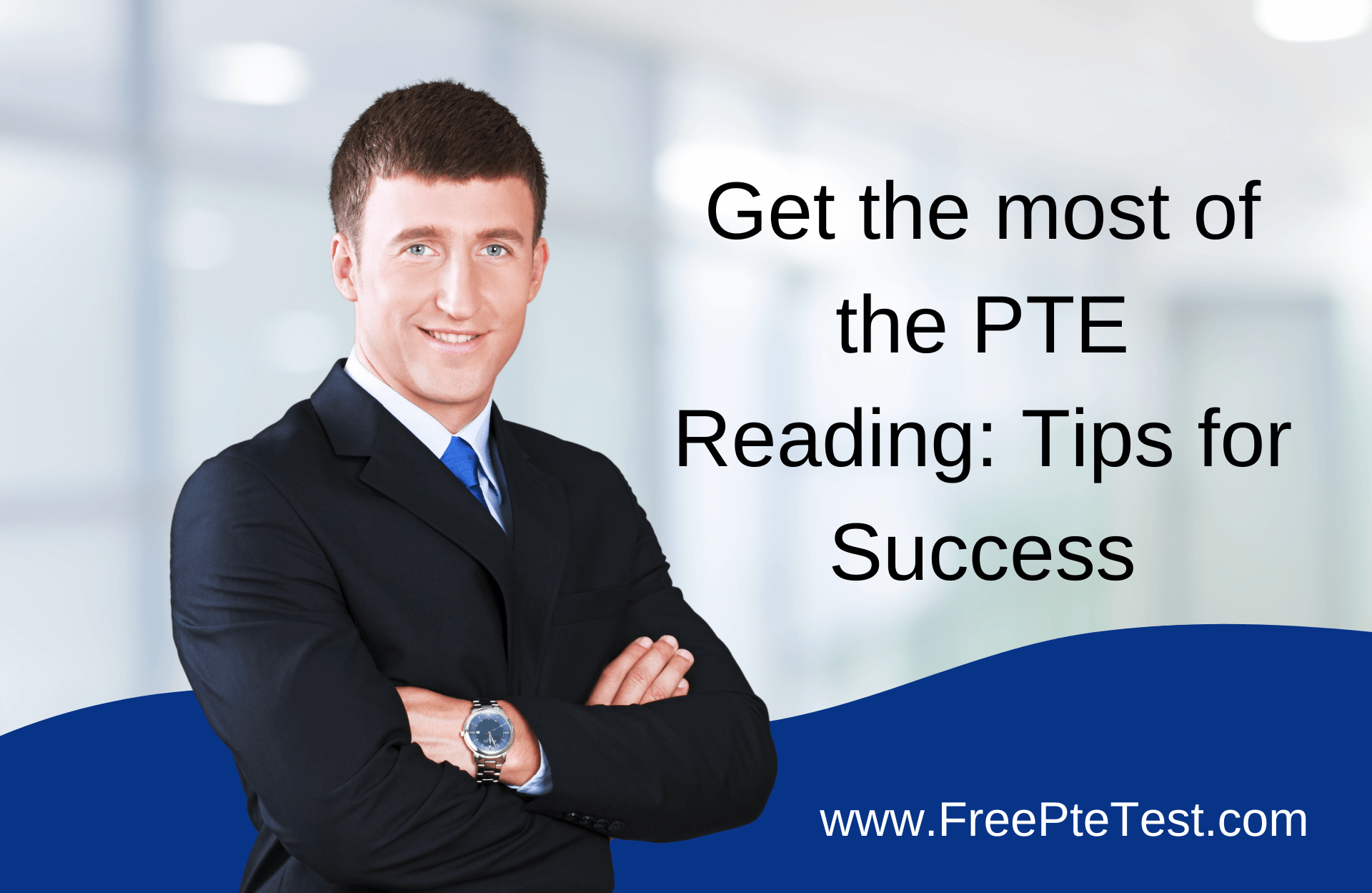PTE Reading: The Pearson Test of English (PTE) is a computer-based English language proficiency test that assesses your ability to understand and use the English language. One of the key sections of the PTE exam is the Reading section, which evaluates your reading skills in an academic context.
Success in the PTE Reading section is crucial for achieving your desired score, whether it’s for academic or immigration purposes. In this blog, we will provide you with a comprehensive guide on PTE Reading tips to help you ace this section and achieve your goals.
Understanding the PTE Reading Section
The PTE Reading section is designed to test your ability to understand and interpret academic texts. It consists of various question types that assess your reading comprehension skills, including multiple-choice questions, reorder paragraphs, and fill in the blanks. In this section, you will encounter a variety of text types, such as essays, articles, and reports, often related to academic subjects.
Now, let’s dive into the essential tips to improve your performance in the PTE Reading section.
- Management of time: You have limited time to answer each question, so it’s essential to practice reading quickly while maintaining comprehension. You’ll need to strike a balance between reading the text thoroughly and efficiently.
- Skimming and Scanning: Skimming involves quickly glancing over the text to get an overall idea of the content. Scanning, on the other hand, is a more focused search for specific information. Use both techniques to your advantage, as they help you find answers more efficiently.
- Vocabulary Expansion: Having a strong vocabulary is essential for understanding the texts in the PTE Reading section. Reading diverse materials and using vocabulary building resources will help you comprehend texts and answer questions accurately.
- Context Clues: Sometimes, you may come across words or phrases you don’t know. In such cases, rely on context clues to understand the meaning. The surrounding words and sentences can provide valuable hints about the unfamiliar term.
- Practice Regularly: Practice is key to success in the PTE Reading section. Use PTE practice materials and sample questions to familiarize yourself with the format and types of questions you’ll encounter. Consistent practice will improve your reading skills and enhance your speed and accuracy.
- Annotate the Text: While practicing, consider annotating the text. Underline key points, make notes in the margins, or highlight important information. This will help you find answers quickly when you go back to the text.
- Identify the Main Idea: Before you delve into the questions, try to understand the main idea or the central theme of the text. This will give you a better grasp of the content and help you answer questions more effectively.
- Pay Attention to Signal Words: Signal words, such as “however,” “although,” and “therefore,” are often used in academic texts to indicate relationships between ideas. Recognizing these words can help you understand the structure and flow of the text.
- Read Actively: Reading actively means engaging with the text, rather than passively scanning words. Ask yourself questions as you read, summarize the main points, and make predictions about the content. This will enhance your comprehension and retention of the material.
- Eliminate Answers: This will help you eliminate incorrect options more efficiently when you review the choices.
Types of PTE Reading Questions
To further enhance your understanding of the PTE Reading section, let’s explore some of the common question types and strategies for each:
Multiple-Choice, Choose Single Answer
In this question type, you’ll read a passage and then choose the most appropriate answer from the given options. To tackle these questions:
- Read the passage thoroughly to understand its main idea and the author’s viewpoint.
- Carefully analyze the answer choices, eliminating incorrect options.
- Select the answer that aligns with the passage’s content and intent.
Multiple-Choice, Choose Multiple Answers
For this type of question, you’ll need to select all the correct options based on the information in the passage. Follow these steps:
- Read the passage carefully and make notes if necessary.
- Examine each answer choice individually to determine its relevance to the text.
- Select all the options that are supported by the passage.
Reorder Paragraphs
In these questions, you’ll be presented with a jumbled set of paragraphs that you must arrange in the correct order to form a coherent passage. To succeed:
- Focus on the topic sentences and logical connections between paragraphs.
- Start by identifying the paragraph that introduces the main idea or topic.
- Arrange the other paragraphs based on the flow of ideas in the passage.
Fill in the Blanks
This question type requires you to complete sentences with the appropriate words or phrases. Here’s how to approach it:
- Read the entire passage to understand the context of the blanks.
- Identify clues and context that can help you predict the missing words.
- Review the options and select the words that fit seamlessly into the passage.
Reading and Writing: Fill in the Blanks
In these questions, you’ll not only fill in the blanks but also summarize the text’s main point. Follow these steps:
- Read the passage thoroughly to comprehend its central idea.
- Identify the context of the blanks and fill them with appropriate words.
- Summarize the main point of the passage in your own words, ensuring clarity and accuracy.
Highlight Correct Summary
This question type presents you with a summary of the text, and you must determine if it accurately represents the main idea. To answer correctly:
- Read the original text and understand its main point.
- Compare the summary with the original text, evaluating its accuracy and relevance.
- Choose the summary that best captures the main idea of the passage.
Reading and Writing: Fill in the Blanks
For these questions, you need to fill in the blanks in a passage and summarize the main point. Here’s how to tackle them:
- Understand the main idea of the passage by reading it carefully.
- Identify the context for the blanks and choose appropriate words.
- Write a summary of the passage’s main point in your own words, ensuring conciseness and accuracy.
Conclusion
Mastering the PTE Reading section is crucial for achieving your desired score on the exam. To do so, you must employ effective reading strategies, develop a strong vocabulary, and practice regularly. Understanding the question types and their respective strategies is equally important.
Remember that success in the PTE Reading section comes through consistent effort and practice. Implement the tips and strategies provided in this blog, and you’ll be well on your way to acing this essential part of the PTE exam. Good luck with your PTE preparation!
FAQs:
Q1: What is the PTE Reading section, and why is it important?
The PTE Reading section is a part of the Pearson Test of English that assesses your reading comprehension skills in an academic context. It’s essential for achieving a good overall score in the PTE exam, especially if you are aiming for academic or immigration purposes.
Q2: What are the key tips for success in the PTE Reading section?
Some key tips for success in the PTE Reading section include time management, skimming and scanning, vocabulary expansion, practicing regularly, annotating the text, identifying the main idea, paying attention to signal words, reading actively, predicting answers, and understanding different question types.
Q3: How can I improve my vocabulary for the PTE Reading section?
You can improve your vocabulary by reading diverse materials, using vocabulary-building resources, and learning new words in context. Make a habit of noting down and reviewing unfamiliar words, and consider using flashcards and vocabulary apps for additional practice.
Q4: Are there any recommended practice materials for the PTE Reading section?
Official PTE practice materials are highly recommended for preparing for the exam. These materials provide authentic practice questions and sample tests that closely resemble the actual PTE exam. Additionally, there are various PTE preparation books and online resources available to help you practice effectively.
Q5: How do I effectively manage my time in the PTE Reading section?
To manage your time effectively, practice reading quickly while maintaining comprehension. Use skimming and scanning techniques to find information efficiently. Allocate specific time limits for each question type and stick to them. Regular practice will also help you become more time-efficient.
Q6: Can you explain the strategy for the “Reorder Paragraphs” question type in the PTE Reading section?
For the “Reorder Paragraphs” question, start by identifying the paragraph that introduces the main idea or topic. Then, arrange the remaining paragraphs based on the logical flow of ideas within the passage. Look for transitional phrases and topic sentences that connect the paragraphs.
Q7: How can I develop the skill of summarizing the main point in the “Highlight Correct Summary” question type?
To excel in the “Highlight Correct Summary” question, read the original text thoroughly to understand its main point. Compare the provided summaries with the original text and evaluate their accuracy and relevance. Choose the summary that best captures the main idea and maintains the original passage’s context.
Q8: What is the recommended approach for filling in the blanks in the PTE Reading section?
For fill-in-the-blanks questions, read the entire passage to understand the context of the blanks. Identify clues and context that can help you predict the missing words. Review the options and select the words that fit seamlessly into the passage. In “Reading and Writing: Fill in the Blanks” questions, ensure your summary is concise and accurate.
Q9: How can I balance reading the text thoroughly and answering questions quickly?
Balancing thorough reading and quick answering is a skill that comes with practice. Skim the text to get an overall idea, and then delve into more detailed reading when necessary. Before looking at the answer choices, try to predict the answer based on your understanding of the text, which will save time when reviewing the options.
Q10: What are some additional resources to help me prepare for the PTE Reading section?
In addition to official PTE practice materials, you can explore online forums, PTE preparation courses, and PTE coaching services. These resources offer guidance, practice materials, and expert tips to enhance your PTE Reading performance. Don’t hesitate to seek help and collaborate with fellow test-takers to improve your skills.



